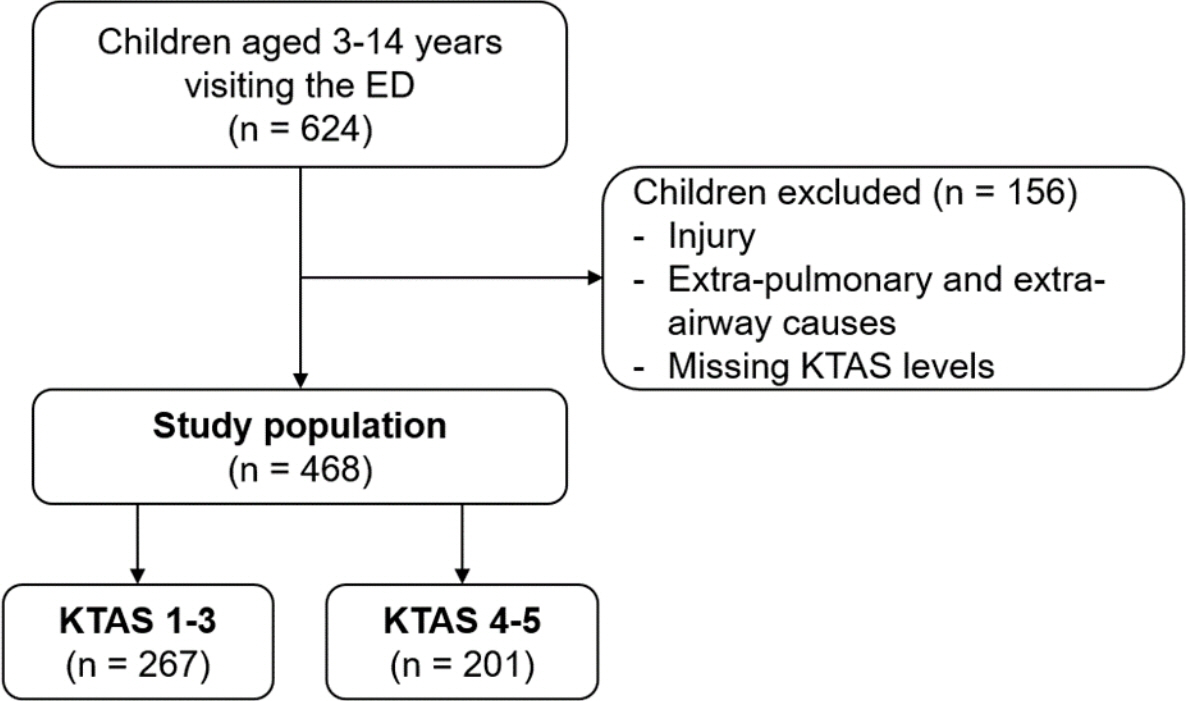Pediatr Emerg Med J.
2022 Dec;9(2):69-75. 10.22470/pemj.2022.00542.
Association between the Korean Triage and Acuity Scale level and severity of children with dyspnea in the emergency department
- Affiliations
-
- 1Department of Emergency Medicine, Uijeongbu St. Mary’s Hospital, College of Medicine, The Catholic University of Korea, Uijeongbu, Republic of Korea
- 2Graduate School of Medical Science and Engineering, Korea Advanced Institute of Science and Technology, Daejeon, Republic of Korea
- KMID: 2538066
- DOI: http://doi.org/10.22470/pemj.2022.00542
Abstract
- Purpose
Triage tools play a vital role in classifying the severity of children in emergency departments (EDs). We investigated the association between the Korean Triage and Acuity Scale (KTAS) and severity of dyspnea in the ED.
Methods
We conducted a retrospective study of children aged 3-14 years with dyspnea who visited the ED from January 2015 through December 2021. They were divided into severe (KTAS level 1-3) and non-severe (KTAS level 4-5) groups. Between the groups, we compared the clinical characteristics, including age, sex, associated symptoms, vital signs, route of visit, treatment at ED, and outcomes.
Results
Among a total of 468 children with dyspnea, 267 and 201 were assigned to the severe and non-severe groups, respectively. The severe group had higher frequencies of fever (21.7% vs. 13.9%; P = 0.031), cough (53.2% vs. 43.3%; P = 0.034), systemic steroids (42.3% vs. 25.9%; P < 0.001), intravenous fluids (47.6% vs. 25.4%; P < 0.001), oxygen therapy (16.5% vs. 6.5%; P = 0.001), inotropics (4.1% vs. 1.0%; P = 0.042), and hospitalization (24.7% vs. 11.9%; P = 0.002). The severe group also showed a higher mean heart rate, respiratory rate, and temperature, and lower mean oxygen saturation (all Ps < 0.001). Among these findings, fever, heart rate, respiratory rate, temperature, intravenous fluids, oxygen therapy, inotropics, and hospitalization remained significantly different between the groups after defining the severe group as a KTAS level 1-2.
Conclusion
This study shows the association between KTAS and severity of dyspnea in the ED. Therefore, KTAS may reflect not only the initial clinical conditions but also emergency measures and outcomes in children with dyspnea who visit EDs.
Figure
Reference
-
References
1. Choi SJ, Yoon HS, Yoon JS. Respiratory distress in children and adolescents. J Korean Med Assoc. 2014; 57:685–92. Korean.2. Park J, Lim T. Korean Triage and Acuity Scale (KTAS). J Korean Soc Emerg Med. 2017; 28:547–51. Korean.3. Kim S, Woo SH, Choi KH, Oh YM, Choi SM, Kyong YY. Association between the Korean Triage and Acuity Scale level and hospitalization of children with abdominal pain in the emergency department. Pediatr Emerg Med J. 2017; 4:97–101. Korean.4. Da Dalt L, Bressan S, Martinolli F, Perilongo G, Baraldi E. Treatment of bronchiolitis: state of the art. Early Hum Dev. 2013; 89 Suppl 1:S31–6.5. Hon KL, Leung KKY, Oberender F, Leung AK. Paediatrics: how to manage acute respiratory distress syndrome. Drugs Context. 2021; 10:2021–1. -9.6. Hirano Y, Madokoro S, Kondo Y, Okamoto K, Tanaka H. Corticosteroid treatment for early acute respiratory distress syndrome: a systematic review and meta-analysis of randomized trials. J Intensive Care. 2020; 8:91.7. Zayed Y, Barbarawi M, Ismail E, Samji V, Kerbage J, Rizk F, et al. Use of glucocorticoids in patients with acute respiratory distress syndrome: a meta-analysis and trial sequential analysis. J Intensive Care. 2020; 8:43.
- Full Text Links
- Actions
-
Cited
- CITED
-
- Close
- Share
- Similar articles
-
- Abuse of the Korean Triage and Acuity Scale in the assessment of emergency medical facilities
- Pre-hospital Korean Triage and Acuity Scale: the development background and core contents
- Validation of the Korean Triage and Acuity Scale Compare to Triage by Emergency Severity Index for Emergency Adult Patient: Preliminary Study in a Tertiary Hospital Emergency Medical Center
- Clinical Considerations When Applying Vital Signs in Pediatric Korean Triage and Acuity Scale
- Appropriateness of triage by emergency medical technician using the Korean Triage and Acuity Scale


